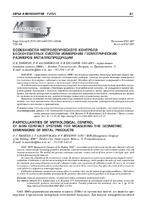Особенности метрологического контроля бесконтактных систем измерения геометрических размеров металлопродукции

Date
2021Publisher
Another Title
Particularities of metrological control of non-contact systems for measuring the geometric dimensions of metal products
Bibliographic entry
Дайнеко, О. В. Особенности метрологического контроля бесконтактных систем измерения геометрических размеров металлопродукции = Particularities of metrological control of non-contact systems for measuring the geometric dimensions of metal products / О. В. Дайнеко, Л. Ф. Калиновская, Н. В. Бессонов // Литье и металлургия. – 2021. – № 1. – С. 91-94.
Abstract
ОАО «БМЗ – управляющая компания холдинга «БМК» для измерения наружных диаметров продукции широко применяет бесконтактные системы измерения геометрических размеров. Системы измерения диаметра используются для получения достоверных, надежных и точных измерений. Методом, обеспечивающим непрерывный и бесконтактный контроль данных систем, является светотеневой способ измерения диаметра. Для обеспечения достоверности результатов измерений системы измерения диаметра должны проходить метрологический контроль – калибровку. Калибровка проводится по разработанной методике, где указываются порядок проведения работ, требования к эталонам, обработка результатов измерений и оценки, оформление результатов калибровки. Для оценки расширенной неопределенности составляется математическая модель, учитывающая все поправки, влияющие на результат оценки, каждая из которых подвергается тщательному анализу. Проведение калибровки систем измерения диаметра позволяет оценить их реальные отклонения в условиях эксплуатации, что дает возможность обеспечить точность и надежность измерения геометрических размеров металлопродукции на всех этапах ее производства.
Abstract in another language
OJSC “BSW–Management Company of the Holding “BMC”, non-contact systems for measuring the outer diameters of products are widely used for measuring geometric dimensions. Diameter measurement systems are used to obtain reliable, true and accurate measurements. The method that provides continuous and non – contact control of these systems is the light -and – dark method of measuring the diameter. To ensure the reliability of the measurement results, the diameter measurement systems must undergo metrological control – calibration. Calibration is carried out according to the developed methodology, which specifies the order of work, requirements for standards, processing of measurement and evaluation results, and registration of calibration results. To assess the extended uncertainty, a mathematical model is created that takes into account all the corrections that affect the result of the assessment, each of which is subjected to a thorough analysis. Calibration of diameter measurement systems allows to evaluate their real deviations in operating conditions, which allows to ensure the accuracy and reliability of measuring the geometric dimensions of metal products at all stages of its production.
View/
Collections
- № 1[22]
